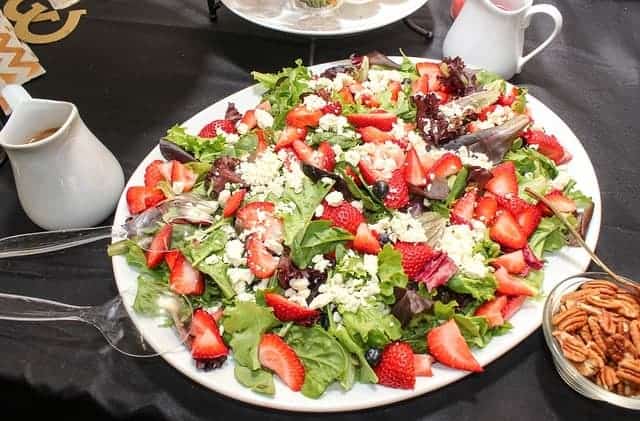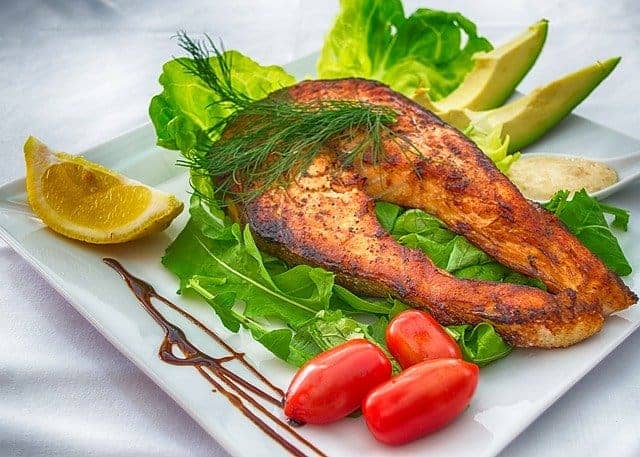The Montignac diet is a long-term eating plan that will help us gradually lose excess weight. Although it is not a very strict diet, it brings with it considerable changes in the way of eating and excludes a wide range of products from the menu. The rate of weight loss on the Montignaca diet is moderate, which gives us a much better chance of losing weight permanently and without the yoyo effect than on short and strict diets (such as the Copenhagen diet). Find out more about the Montignaca diet, learn its principles and check how to compose your meals.
Table of contents
These pernicious carbohydrates …
Michel Montignac is a French pharmacist, who in the 80s of the twentieth century developed a system of diets leading to the loss of excess weight by normalizing the work of the pancreas and regulating carbohydrate metabolism in the body. The creator of the diet noticed that the process of putting on weight is usually connected with too many carbohydrates in the diet. Weight gain is the result of rapid spikes in blood glucose and what happens in our body after eating a large amount of sugars, that is, the overproduction of insulin by the pancreas.
After eating a meal high in carbohydrates with a high glycemic index, there is a rapid rise in blood glucose levels. The pancreas then produces large amounts of insulin to neutralize these levels. The blood glucose level is equalized, some of the sugars are used up by the body, and the excess is stored in the form of body fat.
Montignac therefore suggests that we avoid carbohydrate products with a high glycemic index. In this way, our body will not experience sudden spikes in blood sugar, insulin spikes, and then pushing excess carbohydrates into fat reserves. This is how we will stop gaining weight.
Because the Montignac diet leads to a reduction of body fat, while regulating sugar metabolism in the body, it is successfully used both by overweight people who do not yet have pre-diabetes or diabetes, as well as by people who have such disorders, including people with insulin resistance and diabetics.
Glycemic index an important factor in the Montignaca diet

The Montignac diet (or MM diet), like the popular South Beach diet, is based on the glycemic index of food items. The glycemic index is an indicator of whether a food causes a large or small increase in blood sugar levels. Based on the glycemic index, there are 3 categories of foods:
- low GI foods (0 to 55 GI),
- products with a medium glycemic index (56 to 70 GI),
- products with a high glycemic index (more than 70 GI).
We should build our menus around low-GI foods to help us lose weight and, at the same time, to “repair” our carbohydrate imbalance and reduce the risk of diabetes. Products with lower GI values ensure the feeling of satiety after a meal for a longer time, prevent attacks of ravenous hunger and prevent excess carbohydrates being pushed into fat reserves.
Montignac diet – forbidden and allowed products
The Montignaca method excludes from the menu products with high and medium glycemic index. It mainly includes starchy foods and those which contain higher amounts of simple sugars.
Products prohibited on the Montignaca diet
- processed foods,
- potatoes,
- certain fruits (e.g. watermelon, papaya, melon, ripe banana),
- white bread,
- white pasta, dumplings, pies and other white flour products,
- corn,
- sugar,
- sweets,
- jams and honeys,
- dried fruit,
- white rice,
- carbonated beverages,
- beer,
- fast food.
On the other hand, carbohydrate products with a low GI are allowed in the MM diet, as well as protein products such as fish, lean meat and dairy products. As for fats, it is best to use them in moderation, trying to choose the healthier varieties, such as olive oil and vegetable oils.
Products allowed in the Montignaca diet
- Vegetables,
- legumes such as chickpeas, beans, soybeans, lentils, green beans, peas,
- coarse groats,
- some raw fruits (e.g. pears, apples, peaches, cherries, cherries, grapefruits, oranges, plums, currants, strawberries)
- wholemeal bread, wholemeal rye sourdough bread, pumpernickel,
- wholemeal pasta (cooked al dente),
- whole grain rice, wild rice,
- oatmeal, rye and other unleaned cereals,
- bran,
- lean dairy products,
- eggs,
- lean meat,
- fish,
- seeds (e.g. sunflower, chia seeds, sesame, pumpkin, linseed)
- nuts,
- oil,
- vegetable oils.
Note, the glycemic index is determined not only by the type of food, but also by several other factors, including how it is cooked.
Here are some tips to reduce the GI value of foods:
- Try to reach for raw vegetables and fruits as often as possible – these have a lower glycemic index than cooked ones.
- When you cook vegetables, cereals or rice, don’t overcook them or grind them too much; it’s better if their consistency remains slightly firm.
- If you happen to reach for a product with a high GI, combine it with products with a low GI. This will lower the glycemic value of the whole meal.
- Never combine high-GI foods with fats.
- Choose fruit and vegetables that are less ripe. The riper they are, the higher their GI.
- Try to add high-fibre products to most meals, as this delays the release of carbohydrates from the food and prevents sudden spikes in blood sugar.
- Add variety to your menu with pickles and fermented foods. Sauerkraut, fermented vegetable drinks (e.g. soy milk, oat milk, coconut milk), pickles, yoghurts, buttermilk, kefir, curdled milk, are products that, due to the probiotic bacteria present in them, support the development of a proper gastrointestinal microflora and help regulate blood sugar levels.
Montignaca diet rules

In the Michel Montignaca diet, you do not need to count calories or limit yourself to only a few products in the menu. In this respect, the diet is quite liberal, which will certainly please those who do not like culinary regimes, monotonous meals, portion sizes and, consequently, constant companion in the form of hunger.
When following the Montignaca diet we have 4 meals a day at our disposal, during which we can eat as much as we need to satisfy our hunger. However, we can not eat everything, we should use only products that do not cause sudden spikes in blood sugar, and consequently – weight gain.
In addition, the creator of the diet has defined a few simple rules of eating, which, if followed, will stabilize the sugar balance and cause a gradual weight loss.
The main principles of the Montignaca diet:
- We eat fruits alone, without the company of other products, we eat them either on an empty stomach or half an hour before a meal.
- Eat bread only for breakfast. We use wholemeal bread or sourdough rye bread.
- Do not eat products made of white flour. If we reach for pasta or rice, it should be from whole grain. Pasta, rice and groats should be cooked al dente.
- In the first phase, we try to reach for products with a GI lower than 35.
- Do not eat products with a GI higher than 50.
- Carbohydrates are combined with proteins or proteins with fats in one meal. We avoid combining carbohydrates with a GI greater than 35 with fats. For example, you could have a carbohydrate-protein breakfast, a protein-fat lunch, and a low carbohydrate dinner (eg. cottage cheese plus vegetables (tomatoes, radishes, cucumbers).
- Breakfast should be rich and filling. Lunch should be normal and satisfy your hunger, dinner should be light but not too light. Between lunch and dinner you can have an afternoon snack.
- Take breaks between meals not shorter than 3 hours. If you eat fatty foods as part of a meal, you should eat your next meal in 4 hours. Eat your dinner 3 hours before going to bed.
- Eat regularly. Do not skip meals or snack. Drink non-carbonated mineral water between meals (about 2 l a day).
- Do not drink alcohol. A glass of dry red wine with dinner can be an exception from time to time.
- We try to avoid strong coffee.
Montignac diet – phases
Phase 1 of the Montignaca diet should last about 2-3 months, until you reach a normal weight. During this phase we stick to all the rules mentioned above.
In phase 2, which can last for months, years or even until the end of life, we can slightly liberalize the menu. For example, we can eat foods with a GI higher than 35 more often than in phase 1 (but we still try to avoid foods with a GI higher than 50).
In phase 2 of the Montignaca diet, we can occasionally indulge in foods with a higher GI (e.g. potatoes, white rice, pancakes, pizza) but we should try to neutralize the GI value of the entire meal by adding a low-GI product (e.g. rice, potatoes, lots of lettuce, cucumbers, tomatoes or other raw vegetables). If this is not possible, during the next few meals you should only eat products with a GI lower than 35.
The Montignac diet – effects
During the first phase of the Montignaca diet we lose weight at a rate optimal for our body. During the first phase of the diet we lose about 1-2 kg per week, which gives 4-8 kg in a month. After reducing all excess weight, we move to the second phase, which is designed to maintain the effects.

Seemingly complicated, but in fact simple – if we just take into account the tables presenting the glycemic index of individual products and implement a few basic rules of menu composition, the Montignac diet may turn out to be an effective way to lose weight and improve health.
Here is a sample menu for phase one. In the second phase, as already mentioned, we eat in a similar way, but we can allow ourselves small deviations.
Day 1
- Breakfast: pumpernickel bread (about 3 slices) with lean chicken ham, mozzarella cheese light, tomatoes and olives, a glass of chokeberry or black currant juice without added sugar (carbohydrate-protein meal)
- Dinner: cream of tomato soup with natural yoghurt, seasoned turkey breast steak fried in a little oil, salad of Chinese cabbage, peppers, carrots with vinaigrette (carbohydrate-protein meal)
- Tea time: yoghurt with sunflower seeds
- Dinner: roast chicken leg, Greek salad (protein and fat meal)
Day 2
- Breakfast: wholemeal bread sandwiches with egg, mushroom, ham and chive paste (with natural yoghurt and mustard), tomato, pickled cucumber, salad, a glass of apple and lemon juice (carbohydrate-protein meal)
- Lunch: a casserole of courgettes, aubergines, peppers, green beans, broccoli with tomato sauce, minced chicken meat and yellow cheese (protein and fat meal)
- Afternoon snack: handful of nuts, smoothie from a blender with buttermilk and strawberries
- Dinner: grilled cod, stewed spinach (carbohydrate and protein meal)
Day 3
- Breakfast: toast from wholemeal bread with cheese and tomato, oatmeal on skim milk with nuts, grapefruit juice (carbohydrate-protein meal)
- Dinner: cauliflower soup (without potatoes), pork loin or ham baked in herbs, carrot and sauerkraut salad (carbohydrate-protein meal)
- Afternoon: fruit salad (e.g. apple, pear, peach, raspberry)
- Dinner: salad of tuna, hard-boiled eggs, radishes, cucumber, peppers and cherry tomatoes with vinaigrette (carbohydrate-protein meal)
Day 4
- Breakfast: graham bread with smoked cottage cheese, turkey tenderloin, lettuce and cucumber, kefir and blueberry cocktail (carbohydrate-protein meal)
- Lunch: spring onions (without potatoes), roast salmon, broccoli or green beans with water (fat and protein meal)
- Tea time: brown rice with stewed apple
- Dinner: pate of beans or lentils and other vegetables, tomato, pepper (protein and carbohydrate meal)
Check: Ranking of tablets for weight loss

